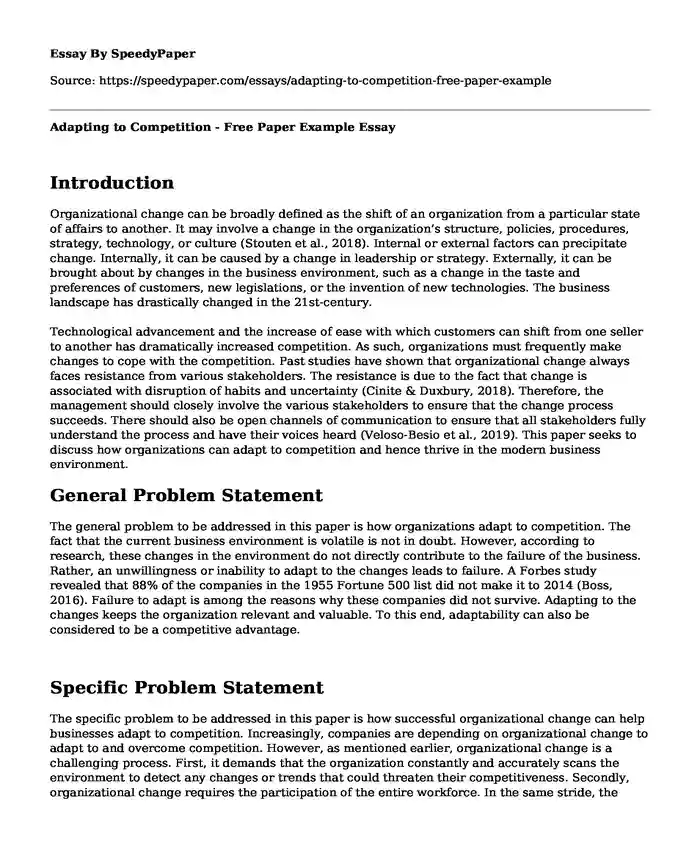
| Type of paper: | Essay |
| Categories: | Business Organizational behavior |
| Pages: | 4 |
| Wordcount: | 891 words |
Introduction
Organizational change can be broadly defined as the shift of an organization from a particular state of affairs to another. It may involve a change in the organization’s structure, policies, procedures, strategy, technology, or culture (Stouten et al., 2018). Internal or external factors can precipitate change. Internally, it can be caused by a change in leadership or strategy. Externally, it can be brought about by changes in the business environment, such as a change in the taste and preferences of customers, new legislations, or the invention of new technologies. The business landscape has drastically changed in the 21st-century.
Technological advancement and the increase of ease with which customers can shift from one seller to another has dramatically increased competition. As such, organizations must frequently make changes to cope with the competition. Past studies have shown that organizational change always faces resistance from various stakeholders. The resistance is due to the fact that change is associated with disruption of habits and uncertainty (Cinite & Duxbury, 2018). Therefore, the management should closely involve the various stakeholders to ensure that the change process succeeds. There should also be open channels of communication to ensure that all stakeholders fully understand the process and have their voices heard (Veloso-Besio et al., 2019). This paper seeks to discuss how organizations can adapt to competition and hence thrive in the modern business environment.
General Problem Statement
The general problem to be addressed in this paper is how organizations adapt to competition. The fact that the current business environment is volatile is not in doubt. However, according to research, these changes in the environment do not directly contribute to the failure of the business. Rather, an unwillingness or inability to adapt to the changes leads to failure. A Forbes study revealed that 88% of the companies in the 1955 Fortune 500 list did not make it to 2014 (Boss, 2016). Failure to adapt is among the reasons why these companies did not survive. Adapting to the changes keeps the organization relevant and valuable. To this end, adaptability can also be considered to be a competitive advantage.
Specific Problem Statement
The specific problem to be addressed in this paper is how successful organizational change can help businesses adapt to competition. Increasingly, companies are depending on organizational change to adapt to and overcome competition. However, as mentioned earlier, organizational change is a challenging process. First, it demands that the organization constantly and accurately scans the environment to detect any changes or trends that could threaten their competitiveness. Secondly, organizational change requires the participation of the entire workforce. In the same stride, the management must strive to overcome resistance from various quarters. Finally, the process must be people-centric to ensure the longevity of the targeted change. When this process is successfully implemented, the organization transforms itself into an entity capable of detecting, creating, as well as implementing changes that help maintain its position as an industry leader (Wang, 2019).
Strategies
Organizational change is one of the strategies that businesses can use to adapt to and overcome competition. However, for the full potential of organizational change in enhancing the competitiveness of a business to be realized, the process must be appropriately implemented. The process calls for the management to be proactive and people-centered. When well-designed and implemented, organizational change can effectively help businesses create a competitive advantage.
Context
As earlier mentioned, organizational change is a complex process. This notwithstanding, it is a primary determinant of organizations that thrive and those that fail. Thus, it is important to explore the experiences that various businesses have had with organizational change. The findings of this exploration can help make a correlation between organizational change and business success. Resistance is one of the major barriers faced in the implementation of organizational change. Understanding the steps that can be taken to overcome resistance, therefore, is necessary for successful organizational change.
Conclusion
Organizational change has been cited as one of the strategies that can be used to enhance the competitiveness of an organization. Hence, it is vital to determine the association between the two variables. The success of organizational change is largely pegged on the implementation process. Therefore, it is necessary to establish the impact that the implementation process has on the organizational process. Cumulatively, these questions will help present organizational change as a potent tool in enhancing the competitiveness of an organization.
References
Boss, J. (2016, April 26). Staying competitive requires adaptability. Retrieved from Forbes: https://www.forbes.com/sites/jeffboss/2016/04/26/staying-competitive-requires-adaptability/#75c6c9557e6f
Cinite, I., & Duxbury, L. E. (2018). Measuring the behavioral properties of commitment and resistance to organizational change. The Journal of Applied Behavioral Science, 54(2), 113-139. Retrieved from https://journals.sagepub.com/doi/abs/10.1177/0021886318757997
Stouten, J., Rousseau, D. M., & De Cremer, D. (2018). Successful organizational change: Integrating the management practice and scholarly literatures. cademy of Management Annals, 12(2), 752-788. Retrieved from https://journals.aom.org/doi/abs/10.5465/annals.2016.0095
Veloso-Besio, C. B., Cuadra-Peralta, A., Gil-Rodriguez, F., Ponce-Correa, F., & Sjoberg-Tapia, O. (2019). Effectiveness of training, based on positive psychology and social skills, applied to supervisors, to face resistance to organizational change. Journal of Organizational Change Management. Retrieved from https://www.emerald.com/insight/content/doi/10.1108/JOCM-04-2018-0099/full/html
Wang, C. H. (2019). How organizational green culture influences green performance and competitive advantage. Journal of Manufacturing Technology Management. Retrieved from https://www.emerald.com/insight/content/doi/10.1108/JMTM-09-2018-0314/full/html.
Cite this page
Adapting to Competition - Free Paper Example. (2023, Nov 26). Retrieved from https://speedypaper.net/essays/adapting-to-competition-free-paper-example
Request Removal
If you are the original author of this essay and no longer wish to have it published on the SpeedyPaper website, please click below to request its removal:
- Skinner vs Rogers - Free Essay on Humanism and Behaviorism
- Engstrom Auto Mirror: Root Cause Case Study Analysis
- Essay Sample on Theories of Administration
- Paper Example. Qualities and Skills of Management Consultants
- Paper Example. Stakeholder Management Concept
- Free Essay Sample: Human Resource Issues.
- Paper Example. Aircraft Stability and Control Parameters
Popular categories




